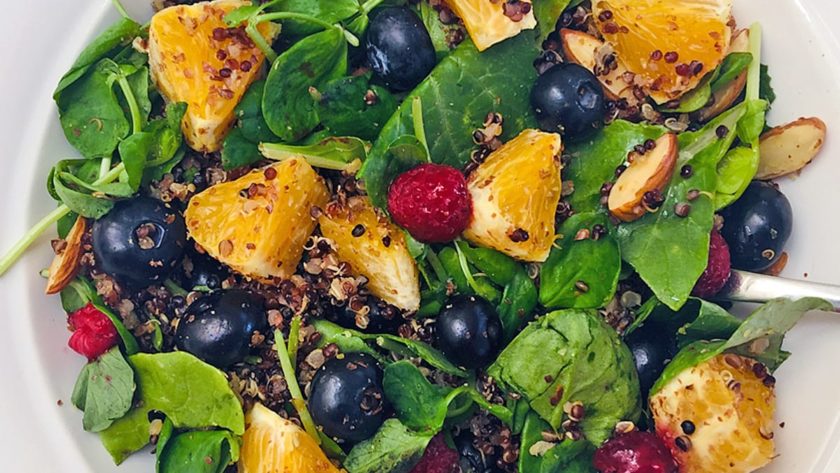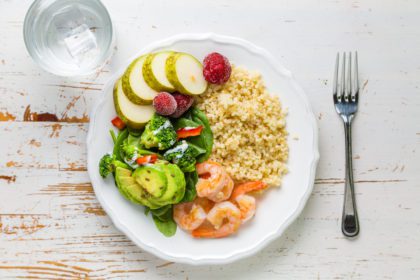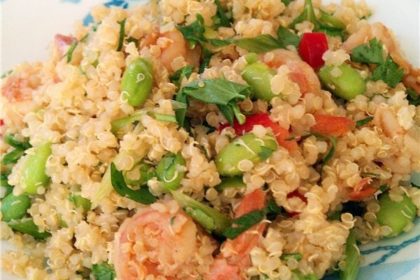When it comes to following a whole food, plant-based lifestyle, I’m often asked how to translate the “Healthy Plate” concept to breakfast. The plate method is a way to portion your food in a healthy way. It makes meal planning easier and adaptable to wherever you are.

Here’s how…
- Fill half of a 9″ plate with non-starchy vegetables (such as, carrots, broccoli, spinach, cabbage, green beans, peppers, zucchini, onions, greens, tomatoes, or romaine lettuce.)
- Fill one-quarter of your plate with a plant-based protein (such as cooked beans, lentils, or tofu).
- Fill one-quarter of your plate with whole grains or starchy vegetables, for example:
- “Intact” grains (e.g., brown, black or red rice), quinoa, bulgur, farro, barley, amaranth), millet;
- Sprouted grains (e.g., Ezekiel sprouted grain bread, English muffins, or tortillas);
- Legumes (e.g., lentil, chickpea, edamame, black bean) or legume + quinoa pasta (the legumes and this type of pasta can also be in your protein quadrant)
- Starchy vegetables (e.g., corn, peas, potatoes, sweet potatoes)
Also include:
- 3 fruit servings a day (e.g., a small orange, banana, or apple) or 1 cup of berries or melon
- A small amount of healthy fat (e.g., extra virgin olive oil, avocado oil, walnut oil, or a small handful of unsalted raw or dry roasted nuts)
- At least one dark green leafy salad a day.
- 2-3 cups of a dairy substitute (e.g, unsweetened soy, hemp, oat, or almond milk, dairy-free yogurt). Be sure non-dairy alternatives do not contain phosphates.

The answer is… a Breakfast Salad! This plant-based breakfast is comprised of leafy greens (half of your plate) and quinoa (one quarter of your plate) which covers both quadrants as a healthy grain and complete protein. A healthy breakfast should include these three components: 1) a protein, 2) whole grain, and 3) healthy fat (the dressing, flaxseed, and almonds). Nuts are a good source of protein too.
 If you’re short on time and want to make some healthy food fast, buy fully-cooked organic frozen quinoa. Just heat up the quinoa in the microwave or on the stovetop for a few minutes. Frozen brands to try (with no added salt): Trader Joe’s® Fully-Cooked Organic Quinoa or Lundberg Family Farms® Ready to Heat Organic California Basmati & Quinoa.
If you’re short on time and want to make some healthy food fast, buy fully-cooked organic frozen quinoa. Just heat up the quinoa in the microwave or on the stovetop for a few minutes. Frozen brands to try (with no added salt): Trader Joe’s® Fully-Cooked Organic Quinoa or Lundberg Family Farms® Ready to Heat Organic California Basmati & Quinoa.
What’s In It…
 Quinoa
Quinoa
- 1 cup organic Lundberg Family Farms® Tri-Color Quinoa (a blend of organic white, brown, red, and black seeds), dry* OR 3 cups frozen fully-cooked organic quinoa
- A drizzle of avocado oil, cold-pressed, unrefined (Avocado oil has a rich, buttery flavor and a high smoke point, but you can use olive oil or safflower oil.)
- 2 cups water
*If you’re in a hurry, opt for 2 (8 oz) packages of precooked microwaveable or ‘ready-to-heat’ quinoa and skip to step 4.
Dressing
- 1/4 cup + 1 tablespoon extra virgin olive oil, cold-pressed, unrefined
- 2 tablespoons organic white balsamic vinegar (Balsamic vinegar is made from grapes, so be sure it is organic since grapes have been tested to be highly contaminated with pesticides. See EWG’s “Dirty Dozen” list.)
 1 tablespoon Super Dense Raspberry Balsamic Glaze (I get this at Whole Foods.)
1 tablespoon Super Dense Raspberry Balsamic Glaze (I get this at Whole Foods.)- 1/2 teaspoon Dijon mustard
- 1/4 teaspoon kosher salt
- 1/4 teaspoon coarse black pepper
Salad
- 1 cup organic fresh or frozen blueberries (about 5 oz.)
- 1/4 cup organic fresh or frozen raspberries
- 1 oz (~25 almonds; 1/4 cup) raw whole almonds, sliced (cut lengthwise into 3 pieces) OR buy 1 package of slivered almonds
- 1 medium orange, peeled, sectioned and sliced into small chunks
- 1 full package (4.2 oz) Organic Girl® Protein Greens OR baby spinach
- 1/4 cup Bob’s Red Mill® organic golden flaxseed meal
How It’s Made…

Tri-Color Blend Quinoa is a blend of white, brown, red, and black seeds If you’re using fully cooked quinoa, reheat as directed and skip to Step 4. Rinse uncooked quinoa in a fine mesh sieve with cool running water for 2 to 3 minutes (until water runs clear). Agitate the seeds with your hands. The rinsing will start hydrating the seeds making them more apt to pop open, and it removes some of the seeds’ natural coating called saponin (a phytochemical). Clinical studies have suggested that saponins have a health-promoting benefit, but they can impart a bitter taste.
- Optional step: I like to toast the seeds before cooking them. The toasting brings out their nutty flavor and makes for a more flavorful, sweeter grain. Warm a drizzle of avocado oil (1-2 teaspoons) in a medium saucepan over medium-low heat. Add the rinsed and drained quinoa, and stir constantly for 8 minutes. Keep an eye on it, so it doesn’t burn.
- Add 2 cups water to the quinoa and turn the heat up to high. When the quinoa comes to a full boil, turn the heat down to medium-low, cover, and let it simmer gently for 17 minutes. (All the water should be absorbed and the kernels should have “popped open”.)
- In a small bowl, whisk together the dressing ingredients: olive oil, white balsamic, raspberry balsamic, Dijon mustard, and salt/pepper.
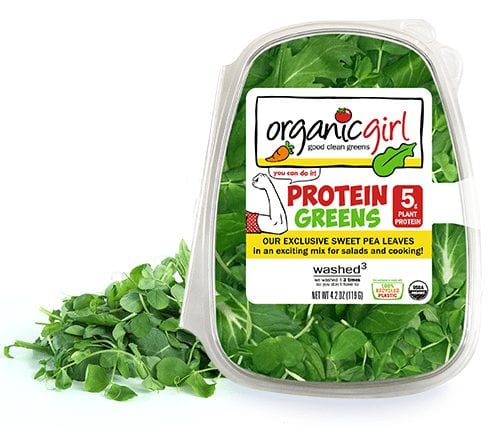
- Divide the Protein Greens into four bowls* (1-1/2 cups or 1.05 oz per bowl).
- Layer each bowl with:
- 1/4 cup blueberries
- 1 tablespoon of raspberries
- One fourth of the cut orange sections
- 1 tablespoon almonds
- 1 tablespoon ground flaxseed meal
7. Pour dressing evenly over each salad.
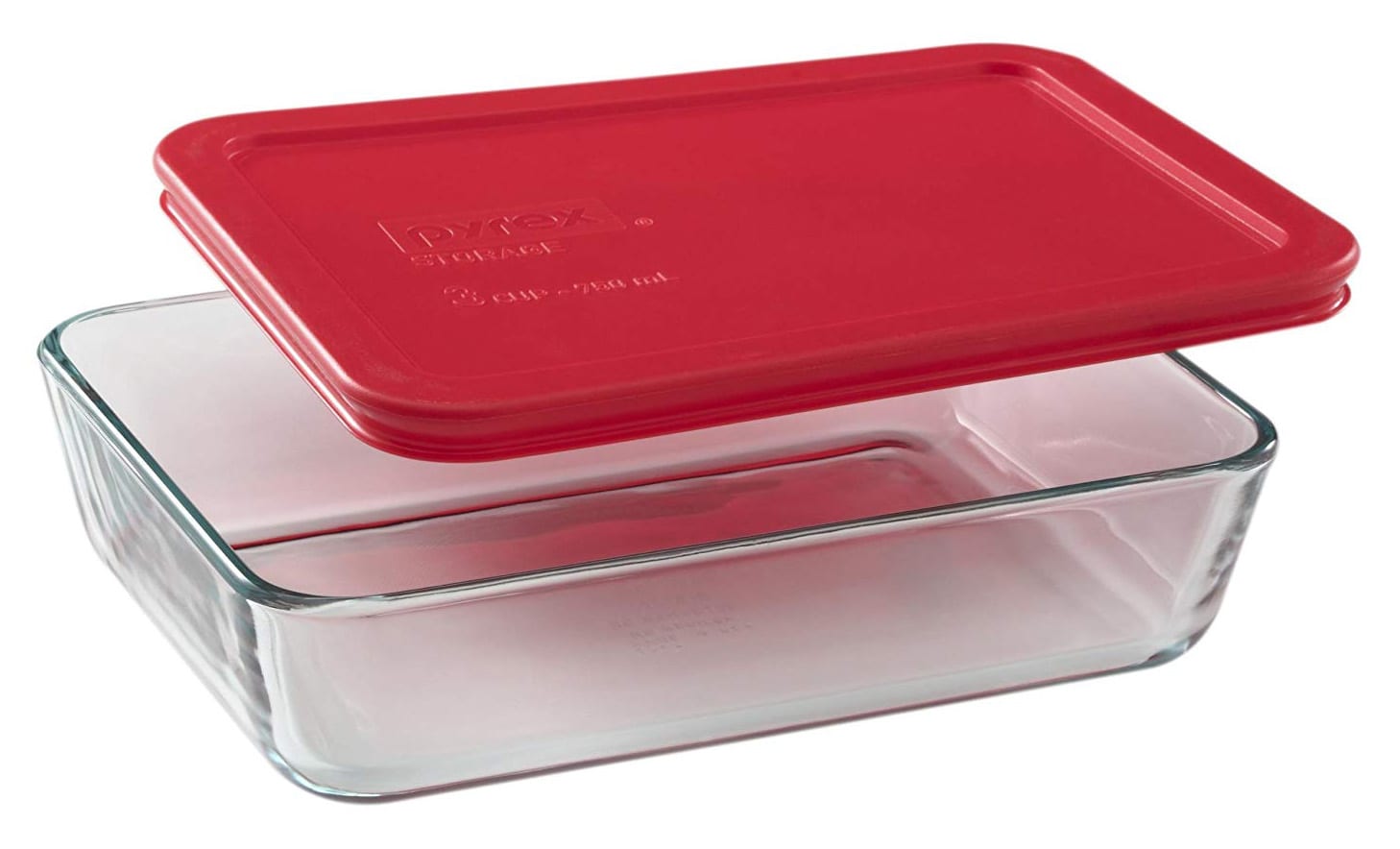 *If you’d like to prepare this salad the night before, you can put each serving into a 3-cup glass container, cover, and chill overnight. Makes a great grab ‘n go breakfast!
*If you’d like to prepare this salad the night before, you can put each serving into a 3-cup glass container, cover, and chill overnight. Makes a great grab ‘n go breakfast!
![]() Karen’s Fit Tip: This salad can be eaten throughout the year. You can opt for frozen berries or whatever fruit is in season. Dried fruit also works well in this breakfast salad.
Karen’s Fit Tip: This salad can be eaten throughout the year. You can opt for frozen berries or whatever fruit is in season. Dried fruit also works well in this breakfast salad.
Makes 4 servings.
xo

